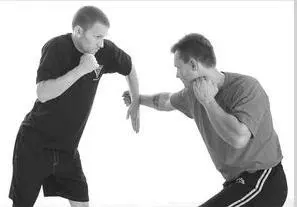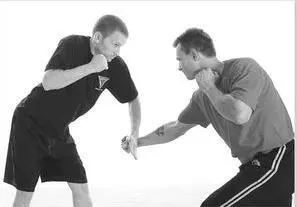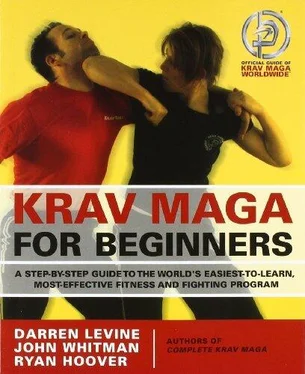Position 3: Starting with your elbow bent 90°, send your forearm out parallel with the floor (with both arms it would look like horizontal goalposts) to defend against an attack coming directly from the side.
Position 4: Bring your elbow (bent 90°) in tight to your body to defend against an upward attack to your ribs. Angle your forearm slightly outward and contract your abs.

Position 5

Position 6

Position 7
Position 5: With your elbow bent 90°, point your fingers down to defend against an upward attack to your ribs. This is the exact opposite of Position #3.
Position 6: Starting with your elbow bent 90°, lower your arm at a 30° angle to defend against a rising attack to your body. Be sure to bend at your waist, not at your knees.
Position 7: Starting with your elbow bent 90°, lower your forearm below and slightly in front of your chest to defend against a rising attack to the center of your body. Be sure to bend at your waist, not at your knees.
INITIAL COUNTERATTACK→ Straight Punch (page 71). During your initial training, practice the defenses only. Once you’ve learned the basic 360° defenses, you can add a simultaneous straight punch. The punch is generally made to the attacker’s face.
NEUTRALIZING THE ATTACKER→ After the initial counterstrike, the defender should continue to strike with elbows to the body and face. Students must focus on rendering the attacker unwilling or unable to continue the assault.
KEY POINTS
• 90° bend in the elbow
• wrist to wrist
• defend using the blade of your arm
• put weight into your defense (“attack the attack”)
COMMONLY ASKED QUESTIONS
Why should I keep my fingers extended?
Technically, this makes your defense longer, which gives you a better chance to defend even if you’re a little off. More importantly, the 360° defense is reflexive, and reflexive motions are made with open hands or slightly curled fingers, not a real fist. Finally, the more you make a fist, the tighter your forearm muscles will be, which slows down your defense.
Why should I defend “wrist to wrist”?
At this level, defending wrist to wrist gives you the best chance of stopping the attack—if the attack comes lower than you expected, you have your whole forearm available to help block the strike. This is also the foundation of our knife defenses, and, in those defenses, the “wrist to wrist” action helps to control the attacker’s knife hand.
Why is it so important to use the blade of the forearm?
It’s harder, and hurts the attacker.
Why should I bend at the waist when I make the lower defenses?
Bending at the waist allows you to go down to meet the attack with your arm without bringing your body closer to the attack. If you bend at the knees, your body will come closer to the attack.
What is the difference between #4 and #5? They seem to cover the same area.
These two positions do cover the same area (the lower ribs). Position #4 is generally used when your hands are already up, so all you must do is drop your elbow down a little and contract your abs. Position #5 is often made when your hands are already down, so you only need to raise your elbow.
Training Tips:It’s important to realize that the seven positions are only teaching tools. There are, of course, an infinite number of positions and angles between each of the seven we have shown. Remember the key points listed above and you’ll be able to defend from any angle of attack.
You should not think of these defenses as circular, arcing motions of the forearm, using the elbow as a hinge. (To use a pop culture reference from the movie Karate Kid , these are not “wax on, wax off” movements.) Send your entire forearm as one unit, extending from the upper arm and shoulder, rather than “hinging” at the elbow.
Inside Defense against Straight Punch
ATTACK→ The attacker throws a right straight punch to the defender’s face or throat.
IMMEDIATE DANGER→ Being struck. The primary danger is being hit.
SECONDARY DANGERS→ Disorientation, balance. If the initial attack is not blocked, the defender may find himself disoriented by the first strike, or knocked off balance, and therefore open to additional strikes.
SOLUTION→ Inside Defense
1As the attack travels forward, use your left hand to redirect the punch (if he punches with his left, you defend with your right). Push your hand, palm open, forward and inward about 45°, but only a small distance. Let the punch slide along your palm. This will redirect it slightly away from your face. At the same time, make a small body defense by moving your head to the outside. Be sure to keep your elbow down as you defend. This allows you to defend anywhere from the tip of your elbow up to your fingers, just in case the punch travels higher or lower than you expected.

INITIAL COUNTERATTACK→ Straight Punch. During your initial training, practice the defenses only. Once you’ve learned the basic 360° defenses, you can add a simultaneous straight punch with the other hand. The punch is generally made to the attacker’s face.
NEUTRALIZING THE ATTACKER→ After the initial counterstrike, the defender should continue to strike with elbows to the body and face. Students must focus on rendering the attacker unwilling or unable to continue the assault.
KEY POINTS
• redirect the punch by letting it slide along your palm
• do not make the motion too big
• make sure your hand travels forward as well as inward
• make a body defense by moving your head slightly to the outside
COMMONLY ASKED QUESTIONS
I keep slapping at the attacker’s hand. Is that OK?
No. Slapping usually means you’re making too big a motion. Just think of building a ramp and letting the attack slide along your palm or wrist so that it’s redirected away.
Do I have to defend with my palm?
The palm is preferred, but it’s possible that the punch travels higher or lower than you expected (for instance, you may think he’s punching at your nose, but he’s really punching at your throat). In that case, you may end up redirecting the punch with your wrist or forearm. This is exactly why we want your elbow to stay down—so that you can defend anywhere along your forearm.
Why not make a bigger defense? Isn’t it safer to move the punch farther away?
You only need the punch to miss your face. You don’t get bonus points if the punch misses you by a foot rather than an inch. In fact, the farther you move the attacker’s punch, the more out of position your hand is, which means you must recover from your defense at the same time that he is recovering from his punch. If he’s faster, you might lose that race. Making a small defense means that you keep your hands as close to a basic fighting stance is possible, so that you’re prepared to deal with any additional attacks that follow that straight punch.
Читать дальше
















